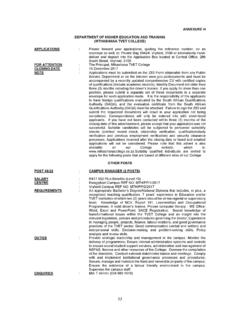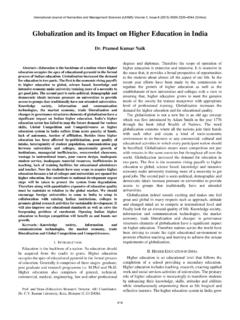Transcription of PUBLIC-PRIVATE PARTNERSHIPS FOR RESEARCH …
1 PUBLIC-PRIVATE PARTNERSHIPS FOR RESEARCH AND innovation : AN EVALUATION OF THE DUTCH EXPERIENCE ORGANISATION FOR ECONOMIC CO-OPERATION AND DEVELOPMENTFOREWORD A major conclusion of the OECD Growth Study was that governments need to be more responsive to the rapid transformation of innovation processes and related business needs and strategies, and that greater use of PUBLIC-PRIVATE PARTNERSHIPS can increase this responsiveness and enhance the efficiency and cost-effectiveness of technology and innovation policy.
2 In the framework of its follow-up work on micro-policies for productivity and growth, the OECD is conducting peer reviews of member countries PUBLIC-PRIVATE partnership (PP/P) programmes for RESEARCH and innovation . This report examines and assesses PP/P initiatives in the Netherlands, with a special focus on the Leading Technology Institutes (LTIs). It has been prepared by the OECD Secretariat,1 in co-operation with the Dutch Ministry of Economic Affairs and in consultation with other stakeholders in LTIs. It takes into account the results of a peer review meeting which took place in June 2003 within the OECD Working Party on Technology and innovation Policy.
3 It is published on the responsibility of the Secretary-General of the OECD. OECD 2004 1. The OECD project team was led by Jean Guinet, assisted by Michael Freudenberg and Byung-Seon Jeong. TABLE OF CONTENTS EXECUTIVE THE ROLE OF PUBLIC-PRIVATE PARTNERSHIPS IN THE DUTCH innovation The Dutch NIS performance and Policy Policy responses: the increasing role of PUBLIC-PRIVATE PARTNERSHIPS ..14 EXAMINATION OF THE LEADING TECHNOLOGY INSTITUTES (LTIs) ..18 Role and purpose: Which gap do LTIs fill within the Dutch NIS?
4 19 Selection Participation of Participation of foreign companies and public RESEARCH 22 Financing ..23 Organisation, governance and Intellectual property rights (IPRs)..26 Conclusions: major policy lessons and open 4 EXECUTIVE SUMMARY Overall, the Netherlands innovation performance is still satisfactory by international standards but there are indications that the Dutch innovation system is losing momentum , due to various bottlenecks that have an increasingly negative impact on its efficiency. This is worrying, because good innovative performance is a necessary condition for Dutch economic performance in the future.
5 One of the most important weaknesses of the Dutch innovation system is inadequate interaction between science/higher education and industry. The Dutch government faces the following main challenges in the field of science and technology policy: Increasing the incentives and improving the institutional frameworks for co-operation between public and private actors of innovation . Improving the attractiveness of the Netherlands as a top location for researchers as well as R&D and other innovative activities. Streamlining and improving the public support schemes for innovation and a complex innovation governance system.
6 Improving interdepartmental co-ordination. PUBLIC-PRIVATE PARTNERSHIPS for innovation (PP/Ps) are an important part of the answer to such challenges. Different models of PP/Ps are already key components of the Dutch innovation policy tool kit. Their significance is qualitatively far more important than would suggest their rather modest share in the overall science and technology budget (around 6%). A key question is whether and how their contribution to boosting Dutch innovation and economic performance could be further improved.
7 This arises in a context where reforms are being contemplated which could complement PP/Ps in improving the interaction between public and private RESEARCH . In particular, the bridging function of many public labs will be evaluated this year, with a view to improve their positioning, steering and funding. The government is also considering modifications of the financing mechanisms of university RESEARCH , with the objective to increase the share of competitive grants relative to that of institutional funding, and to introduce more performance-based criteria (including applicability of RESEARCH for innovation ) in the allocation of institutional funding.
8 It is important that future decisions regarding the actual implementation of these reforms take into account the lessons drawn from practical experience with the management of existing PP/P programmes, which also provide insights regarding the possible improvement of these programmes. Among those, the four Leading Technology Institutes (LTIs) represent one of the purest forms of PP/P, both in their rationale and organisation. The OECD peer review of the LTI programme concluded that it is a proven good practice in mobilizing public and private RESEARCH towards common objectives of high importance for the economy and society.
9 The four LTIs perform well, 5are based on a sound rationale and are implemented efficiently. Other OECD countries could learn from them, especially with regard to: The competitive process that has been used to select LTIs. The organisational arrangements and incentive structure (financing, IPRs) that ensure industry commitment and leadership in determining the strategic RESEARCH orientation of each LTI, while securing the pursuit of public interest ( public access the RESEARCH results, strengthening of public RESEARCH capabilities in fundamental RESEARCH ).
10 But the OECD evaluation also suggests that this new policy tool has not yet been used to its full potential. This would require addressing the following main issues: When streamlining its numerous schemes to promote innovation , the government should improve the balance between competitive and unconditional grants, as well as between project-based and programme-based support. It could consider concentrating more the use of competitive grants within the framework of true PP/P programmes, such as LTIs, ACTs or genomics.
















